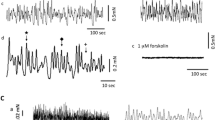Summary
The simultaneous recording of tension and mass electrical activity at both ends of helical strips of the rat aorta was used to investigate the influence of pacemaker frequency and propagation of excitation on vascular tone.
-
1.
Rhythmic contractions as well as a tonic like increase in tension induced by addition of norepinephrine (>0,1 μg/l) or K+ (>10–15 mM/l) are accompanied by potential changes at both ends of the preparation.
-
2.
Changes in amplitude of the potentials are correlated with changes in tension in the same direction.
-
3.
Stepwise increase in noradrenaline or [K+]o leads to a smooth tetanus by increasing the frequency of spontaneous excitations.
-
4.
Moderate increase in [Ca++]o induces a decrease in pacemaker frequency, synchronization of electrical activity, and an enhancement of the amplitudes of rhythmical contractions.
-
5.
Excitation of the smooth muscle of rat aorta is followed by a relative refractory period, which causes a reduction of conduction velocity and decremental conduction.
-
6.
Electrical activity ceases after washout of the vasoactive substances, after a large increase in [Ca++]o, and sometimes spontaneously. In each case relaxation of the preparation is observed.
It is concluded that under these experimental conditions an increase in tension is due to synchronized spontaneous excitations which are propagated over large parts of the preparation. The resulting tone mainly depends on the frequency of pacemaker excitations and on the efficiency of conduction.
Zusammenfassung
Mit der gleichzeitigen Registrierung der mechanischen Spannung und der elektrischen Massenaktivität von beiden Enden eines Rattenaortenstreifens wurde die Beziehung zwischen Gefäßtonus einerseits und Erregungsfrequenzen und-ausbreitung andererseits untersucht:
-
1.
Sowohl bei rhythmischen Kontraktionen als auch scheinbar tonischen Spannungsanstiegen nach Zugabe von Noradrenalin (>0,1 μg/l) oder K+ (>10–15 mM/l) können stets Potentialänderungen an beiden Enden des Präparates abgeleitet werden.
-
2.
Änderungen der Potentialamplituden sind mit gleichgerichteten Spannungsänderungen streng korreliert.
-
3.
Schrittweise Erhöhung der Noradrenalin- oder K+-Konzentration führen schließlich zu einem glatten Tetanus durch Steigerung der Erregungsfrequenz.
-
4.
Mäßige Erhöhung der Ca++-Konzentration bewirkt neben einer Abnahme der Erregungsfrequenz eine Verbesserung der Synchronisation der elektrischen Aktivität und eine Amplitudenzunahme der rhythmischen Kontraktionen.
-
5.
Jede Erregung der glatten Muskulatur der Rattenaorta ist von einer relativen Refraktärphase gefolgt, die anhand einer Abnahme der Ausbreitungsgeschwindigkeit und dem Auftreten einer Dekrementleitung nachgewiesen wird.
-
6.
Sistieren der elektrischen Aktivität tritt an Rattenaortenstreifen nach Auswaschen der vasoaktiven Substanzen, nach starker Erhöhung der Ca++-Konzentration und gelegentlich spontan auf und ist stets von Relaxation des Präparates gefolgt.
Aus den Ergebnissen wird geschlossen, daß unter den dargelegten experimentellen Bedingungen jegliche Spannungszunahme der glatten Muskulatur der Rattenaorta auf synchronisierte, das ganze Präparat oder größere Abschnitte desselben erfassende, sich myogen fortleitende Erregungen zurückzuführen ist, wobei die Höhe des sich einstellenden „Tonus” im wesentlichen von der Frequenz des oder der Schrittmacherzentren und der Effektivität der Erregungsausbreitung abhängt.
Similar content being viewed by others
Literatur
Axelsson, J., Wahlström, B., Johansson, B., Jonsson, O.: Influence of the ionic environment on spontaneous electrical and mechanical activity of the rat portal vein: Circulat. Res.21, 609 (1967).
Biamino, G., Kruckenberg, P.: Synchronisation and conduction of excitation in the rat aorta. Amer. J. Physiol.217, 113 (1969).
——, Klauske, J.: A method to analyse synchronisation and conduction velocity in vascular smooth muscle. Life Sci.8, 157 (1969).
Biamino, G., Kruckenberg, P., Klauske, J., Thron, H. L., Gauer, O. H.: Pacemaker activity and spread of excitation in the spontaneously contracting smooth muscle of the rat aorta. 5th Europ. Conf. Microcirculation, Göteborg 1968. Bibl. anat. (Basel)10, 532 (1969).
—, Thron, H. L.: Spontanrhythmik und contractiler Tonus der isolierten Rattenaorta in Abhängigkeit von der extracellulären Noradrenalin-, K+- und Ca++-Konzentration. Pflügers Arch.305, 361 (1969).
Brecht, K., Estada, J. A., Götz, A.: Zur Beeinflussung der Gefäßmotorik durch Ca++- und K+-Ionen. Ein Beitrag zum Tonusproblem. Pflügers Arch. ges. Physiol.279, 330 (1964).
Bülbring, E.: Changes in configuration of spontaneously discharged spike potentials from smooth muscle of the guinea-pig's teania coli. The effect of electrotonic currents and of adrenaline, acetylcholine and histamine. J. Physiol. (Lond.)135, 412 (1957).
—, Kuriyama, K.: Effect of changes in external sodium and calcium concentration on spontaneous electrical activity in smooth muscle of guinea-pig taenia coli. J. Physiol. (Lond.)166, 29 (1963).
Burgi, S.: Forderung, Hemmung und Desorganisation der arteriellen Eigenrhythmen. Helv. physiol. pharmacol. Acta3, 215 (1945).
Burnstock, G., Prosser, C. L.: Conduction in smooth muscles: comparative electrical properties. Amer. J. Physiol.199, 553 (1960).
Daniel, E. E.: Attempted synthesis of data regarding divalent ions in muscle function. In: Paul, W. M., E. E. Daniel, C. M. Kay and G. Moncktan, ed.: Muscle, p. 295. Oxford: Pergamon Press 1965.
Johansson, B., Bohr, D. F.: Rhythmic activity in smooth muscle from small subcutaneous arteries. Amer. J. Physiol.210, 801 (1966).
—, Jonsson, O., Axelsson, J., Wahlström, B.: Electrical and mechanical characteristics of vascular smooth muscle response to norepinephrine and isoproterenol. Circulat. Res.21, 619 (1967).
—, Ljung, B.: Spread of excitation in the smooth muscle of the rat portal vein. Acta physiol. scand.70, 312 (1967).
Kaufmann, R.: Nachweis einer natürlichen elektro-mechanischen Kopplungsinsuffizienz bei Purkinje-Fäden des Rhesus-Affen. Pflügers Arch. ges. Physiol.294, 235 (1967).
Nakajiama, A., Horn, L.: Electrical activity of single vascular smooth muscle fibers. Amer. J. Physiol.213, 25 (1967).
Prosser, C. L.: Conduction in nonstriated muscles. Physiol. Rev., Suppl.5, 193 (1962).
Tomita, T.: Spike propagation in the smooth muscle of the guinea-pig taenia coli. J. Physiol. (Lond.)191, 517 (1967).
Weidmann, S.: Effects of calcium ions and local anaesthetics on electrical properties of Purkinje fibres. J. Physiol. (Lond.)129, 568 (1955).
Author information
Authors and Affiliations
Additional information
Herrn Prof. Dr. O. H. Gauer zum 60. Geburtstag gewidmet.
Mit Unterstützung der Deutschen Forschungsgemeinschaft (Bi/22/1).
Rights and permissions
About this article
Cite this article
Biamino, G., Kruckenberg, P., Wessel, H.J. et al. Über Beziehungen zwischen Tonus und elektrischer Aktivität der glatten Gefäßmuskulatur. Pflugers Arch. 315, 212–231 (1970). https://doi.org/10.1007/BF00586414
Received:
Issue Date:
DOI: https://doi.org/10.1007/BF00586414
Key-Words
- Isolated Aortic Strip
- Vascular Tone
- Rhythmic Activity
- Conduction of Excitation
- Pacemaker Frequency
- Norepinephrine
- Potassium
- Calcium




